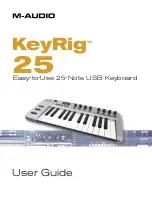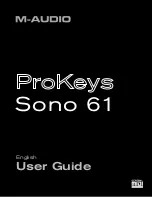
5-2
Editing Conventions
Object Type and ID
Shift patterns
Factory-preset or user-programmed sequences of note shift information,
used by the arpeggiator for detailed arpeggiations, or by the Shift Key
Number controller destination.
Velocity patterns
Factory-preset or user-programmed sequences of note velocity shift
information, used by the arpeggiator for detailed velocity triggering in
arpeggiation.
Master tables
The values that are set for the parameters in Master mode, as well as the
settings for the parameters on the Transmit, Receive, and Channels pages
in MIDI mode, and the programs currently assigned to each MIDI
channel.
Object Type and ID
The PC3A stores its objects in memory using a system of ID numbers that are generally organized
into
banks. Each object is identified by its object type and object ID; these make it unique. An
object’s type is simply the kind of object it is, whether it’s a program, setup, song, or whatever.
The object ID is a number from 1 to the maximum that distinguishes each object from other
objects of the same type. For example, within a bank you can have a setup, a program, and an
effect, all with ID 201; their object types distinguish them. You can’t, however, have two
programs
with ID 201.
Object Type
Object ID
Object Name
Program
201
Hot Keys
Setup
404
Silicon Bebop
Velocity Map
1
Linear
ROM (factory preset) objects have ID numbers in a number of banks. When you save objects that
you’ve edited, the PC3A will ask you to assign an ID. If the original object was a ROM object, the
PC3A will suggest the first available ID in the User Bank (starting at 1025). If the original object
was a memory object, you’ll have the option of saving to an unused ID, or replacing the original
object. Double press the
-
and
+
buttons (beneath the alpha wheel) to select the next available
user location.
Objects of different types can have the same ID, but objects of the same type must have different
IDs to be kept separate. When you’re saving an object that you’ve edited, you can replace an
existing object of the same type by giving it the same ID. The object you are replacing will be
deleted permanently. There is one exception to this: If you write over a ROM object (factory
preset,) you can always revert to the original factory ROM object by deleting you new object that
uses the ID. The object that you had replaced the ROM object with will be permanently deleted,
and the original ROM object will appear in its place.
Many parameters have objects as their values—for example, the Intonation parameter in Master
mode. In this case, the object’s ID appears in the value field along with the object’s name. You can
enter objects as values by entering their IDs with the alphanumeric pad. This is especially
convenient for programs, since their ID numbers are usually the same as their MIDI program
change numbers.
The object type and ID enable you to store hundreds of objects without losing track of them, and
also to load files from storage without having to replace files you’ve already loaded.
















































